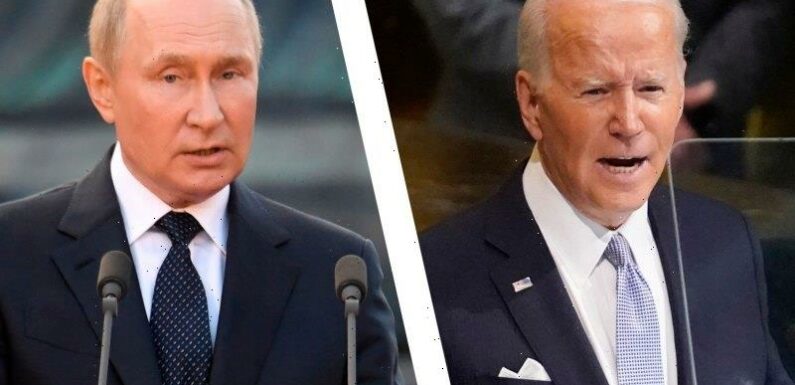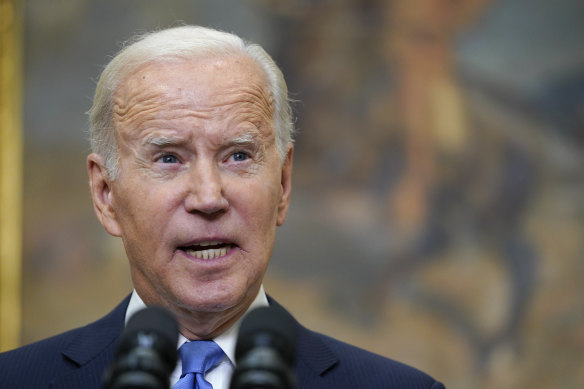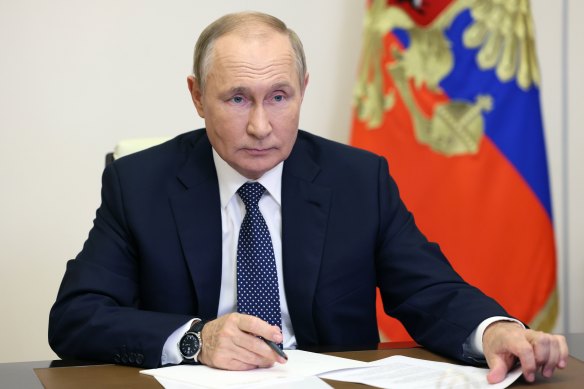
US President Joe Biden’s declaration Thursday night that the world may be facing “the prospect of Armageddon” if President Vladimir Putin uses a tactical nuclear weapon in Ukraine included a revealing side note: that Biden has been looking to help the Russian president find an “off-ramp” that might avert the worst outcome.
His logic came right out of the Cuban missile crisis, to which Biden referred twice in his comments at a Democratic fundraiser in New York, a good indication of what is on his mind. In that famous case – the closest the world came to a full nuclear exchange, 60 years ago this month – President John F. Kennedy struck a secret bargain with Nikita Khrushchev, the Soviet premier, to remove US missiles from Turkey.
US President Joe Biden has warned that the world was facing its biggest nuclear threat since the 1962 Cuban missile crisis.Credit:AP
With that deal, which only came to light later, a disaster that could have killed tens of millions of Americans and Soviet citizens was averted.
For weeks now, Biden’s aides have been debating whether there might be an analogous understanding, a way for the wounded Russian leader to find an out. They have offered no details, knowing that secrecy may be the key to seeking any successful exit and avoiding the conditions in which a cornered Putin reaches for his battlefield nuclear weapons. Karine Jean-Pierre, the White House press secretary, reiterated Friday that Biden had no new intelligence about nuclear weapons use and said she “saw no indications” the Russians were preparing to use them.
After Biden’s remarks, some foreign leaders said they would like to go back to the days when nuclear threats were not discussed in public.
“We must speak with prudence when commenting on such matters,” French President Emmanuel Macron said Friday in Prague.
But as one senior European diplomat said this week that when the history of this era is written, many will be shocked by how much work was underway to assess the risks of a nuclear detonation – and to think about how to deter it. It is a hard topic to talk about in public for most officials, for fear of inducing public panic or market sell-offs.
So it was a surprise that the first member of the administration to talk openly about how to avoid forcing Putin’s hand was the president himself, at the New York home of James Murdoch, the son of Rupert Murdoch, executive chairman of News Corp.
“We’re trying to figure out: What is Putin’s off-ramp?” Biden said in a speech that was largely on domestic initiatives, the Supreme Court’s overturning of Roe v Wade and other issues central to the US midterm elections.
“Where, where does he get off? Where does he find a way out? Where does he find himself in a position that he does not, not only lose face, but lose significant power within Russia?”
Russian President Vladimir Putin has said that the U.S.’s decision to drop atomic bombs on Japan in 1945 set a precedent.Credit:AP
Biden did not answer his own questions, which echo those that his aides have been asking. Nor is it clear that Putin is looking for a way out, at least yet. At just about every turning point in the war over the past seven months, he has reacted to failures among his troops with ever more escalation, calling up untrained recruits, conducting more indiscriminate attacks on cities, reducing gas flows and threatening, of course, to use his ultimate weapons.
Putin’s latest threats came a week ago, when he declared that the US’s decision to drop atomic bombs on Hiroshima and Nagasaki in 1945 set a precedent and that, if necessary, he would follow suit.
Nonetheless, the main message that Biden seemed to be conveying is that he was heeding one of the central lessons of the Cuban missile crisis, which unfolded when Biden was just a month shy of his 20th birthday. That lesson, in his telling, is that the US and its allies need to avoid getting Putin’s back to the wall, forcing him to strike out.
“It’s part of Russian doctrine,” he explained to the well-heeled crowd of potential donors to Democratic senatorial campaigns, that “if the motherland is threatened, they’ll use whatever force they need, including nuclear weapons.”
It is hard to translate Biden’s description of the risks into a strategy that fits the moment. No one in the administration wants to suggest, in public or private, that the government of President Volodymyr Zelensky should avoid chasing Russian troops out of every corner of Ukraine, back to the borders that existed Feb. 23, the day before the invasion began.
But behind closed doors, some Western diplomats and military officials say that is exactly the conversation that may have to happen if the goal is to balance winning back territory against preventing Putin from lashing out. William Burns, the CIA director and the former US ambassador to Moscow during Putin’s rise, said on CBS this week that the Russian leader can be “quite dangerous and reckless” when he feels cornered or “feels his back against the wall.”
Of course, that is exactly the kind of assessment Putin is trying to encourage; his ultimate hope, US intelligence officials say, is to fracture Europe over the question of whether to confront Moscow or appease it.
He has plenty of steps remaining on the escalation ladder: He could conduct exercises with his nuclear-ready troops; he could step up cyberattacks outside Ukraine’s borders; and he could make use of chemical weapons, as he has done in the past, against dissidents and other targets. Then, of course, there is the possibility of attacks on energy infrastructure – perhaps similar to what happened last week, mysteriously, to the Nord Stream I and II gas pipelines.
But what the administration says it is looking for are incentives for Putin to de-escalate – a search that appears fraught.
One of Putin’s periodic demands is that NATO pull back its forces from former Soviet states and not conduct what he calls provocative exercises on its borders. Early this year, he demanded that NATO sign a treaty that would have essentially rolled the alliance back to what it looked like in the late 1990s.
Many Eastern European officials, concerned about Putin’s next territorial ambition, say they want NATO in their countries more than ever. To them, this is a time to build up defences, not pull back. But some Western European officials say they could imagine scaling back on exercises or conspicuous reinforcement of troops, even temporarily. Over the summer, the Biden administration also delayed some missile tests to avoid unnecessary provocations.
All those would be temporary moves, and Putin is clearly looking for a permanent alteration in NATO’s stance. And he is not likely, many officials insist, to stop invoking the power of his nuclear arsenal as long as his ground troops are struggling.
This article originally appeared in The New York Times.
Most Viewed in World
From our partners
Source: Read Full Article

